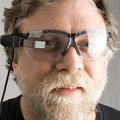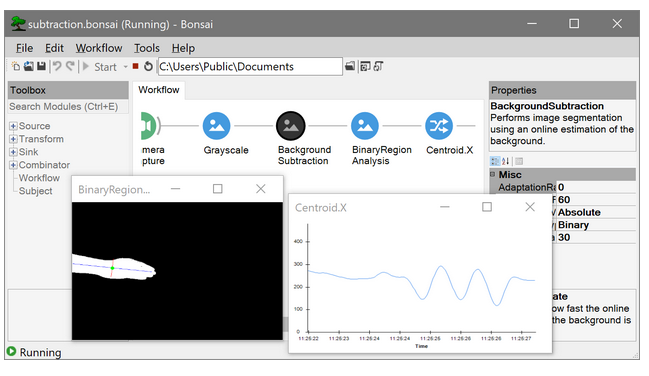![]() what about electromyography? could it be more useful for some uses than the notoriously fickle eeg?
what about electromyography? could it be more useful for some uses than the notoriously fickle eeg?
 Which resulted in a product https://eyedrivomatic.org/
Which resulted in a product https://eyedrivomatic.org/
 @Thomas here is an example paper where OSH does better than commercial tools https://www.nature.com/articles/s41598-017-02301-2
@Thomas here is an example paper where OSH does better than commercial tools https://www.nature.com/articles/s41598-017-02301-2
 @Thomas reproducible results have started to come out of some shared projects, especially ones like DeepLabCut and the Open Miniscope. Many labs are using.
@Thomas reproducible results have started to come out of some shared projects, especially ones like DeepLabCut and the Open Miniscope. Many labs are using.
 I'm thinking openbci could augment this work.
I'm thinking openbci could augment this work.
![]() ...random thought for communication. eyeblink sensing, one for each eye. left-eye blink is dash, right-eye dot, both is end of symbol or ignored.
...random thought for communication. eyeblink sensing, one for each eye. left-eye blink is dash, right-eye dot, both is end of symbol or ignored.
![]() could be a faster alternative to gaze-controlled keyboards.
could be a faster alternative to gaze-controlled keyboards.
 Hi guys, I'm Leonardo Gomes from Brazil and, only to give an example of BCI application, I'm working with EEG for controlling sex toys and helping people with disabilities
Hi guys, I'm Leonardo Gomes from Brazil and, only to give an example of BCI application, I'm working with EEG for controlling sex toys and helping people with disabilities
https://www.mdpi.com/2218-6581/7/3/46 in this first version I used an Emotiv EPOC, but now I'm developing my own BCI based on the OPENBCI project.

 There is a contract mechanism for NSF where they are asking for people to come up with sensor to monitor ANY indication of the state of the patient. Any data stream is possibly and indicator. They do not classify "behavior" but treat it as sensor fusion and looking for patterns.
There is a contract mechanism for NSF where they are asking for people to come up with sensor to monitor ANY indication of the state of the patient. Any data stream is possibly and indicator. They do not classify "behavior" but treat it as sensor fusion and looking for patterns.
![]() thought. can optogenetics be leveraged? something that can be injected to the neurons and make them sensitive to light, or emit light? could work around the issue with electrode stability.
thought. can optogenetics be leveraged? something that can be injected to the neurons and make them sensitive to light, or emit light? could work around the issue with electrode stability.
 @Mark Laubach I agree. Peer review like approaches also work for lab equipment
@Mark Laubach I agree. Peer review like approaches also work for lab equipment


 Thank you!
Thank you!
 welcome!
welcome!
![]() are there major differences between emg and eeg amplifiers/electrodes?
are there major differences between emg and eeg amplifiers/electrodes?
 You can probably use the methods at OpenAI.com to process the raw signals. They seem to be commercial, but they do share their tools on GitHub
You can probably use the methods at OpenAI.com to process the raw signals. They seem to be commercial, but they do share their tools on GitHub
![]() . o O ( Python evaluating the behavior of mice... )
. o O ( Python evaluating the behavior of mice... )
 One thing that we wanted to mention is that if anyone has a project that they have shared, let us know and we can get the word out on it either by a blog post or Tweet, or both. There is a contact form on this page: https://edspace.american.edu/openbehavior/
One thing that we wanted to mention is that if anyone has a project that they have shared, let us know and we can get the word out on it either by a blog post or Tweet, or both. There is a contact form on this page: https://edspace.american.edu/openbehavior/
 Just use a kalman filter it should do the job
Just use a kalman filter it should do the job


 I tracked this sort of thing since high school and later in more detail because my brother broke his neck and was quadraplegic before he died. Wish there had been a Hackaday.IO more thirty five years ago. I am partial to noncontact method like MagnetoEncephalogram, and looked deep into SQUID and other magnetometer methods. Hard working alone.
I tracked this sort of thing since high school and later in more detail because my brother broke his neck and was quadraplegic before he died. Wish there had been a Hackaday.IO more thirty five years ago. I am partial to noncontact method like MagnetoEncephalogram, and looked deep into SQUID and other magnetometer methods. Hard working alone.


![]() @Lex Kravitz both, that's the pun. :P
@Lex Kravitz both, that's the pun. :P
 Very interesting this bonsai!
Very interesting this bonsai!
 Another great resource for tools is https://open-ephys.org/. The provide open systems for recording brain activity using electrodes or calcium imaging (miniscopes) and other tools for behavioral studies such as pyControl. Preassembled items can be purchased for low cost or you can download the designs and parts lists yourself and make stuff on your own.
Another great resource for tools is https://open-ephys.org/. The provide open systems for recording brain activity using electrodes or calcium imaging (miniscopes) and other tools for behavioral studies such as pyControl. Preassembled items can be purchased for low cost or you can download the designs and parts lists yourself and make stuff on your own.

![]() random thought. some sort of nanoparticle that could be embedded in the neuron membrane and mediate the signal. nanoelectronics that could emit an electromagnetic signature a nearby receiver can catch. something small enough with polar sides and nonpolar ring, mimicking the transmembrane protein structure.
random thought. some sort of nanoparticle that could be embedded in the neuron membrane and mediate the signal. nanoelectronics that could emit an electromagnetic signature a nearby receiver can catch. something small enough with polar sides and nonpolar ring, mimicking the transmembrane protein structure.
 @Lex Kravitz this may be very useful for my projects!
@Lex Kravitz this may be very useful for my projects!
![]() can the calcium imaging trick be used in vivo?
can the calcium imaging trick be used in vivo?
 @Thomas Shaddack YES!
@Thomas Shaddack YES!
 @Lex Kravitz and @Leonardo Gomes We are using bonsai too! really great tool
@Lex Kravitz and @Leonardo Gomes We are using bonsai too! really great tool

http://miniscope.org/index.php/Main_Page
UCLA Miniscope
The miniature fluorescence microscope described here is based on a design pioneered by Mark Schnitzer's Lab at Stanford and published in a paper in Nature Methods in 2011. It uses wide-field fluorescence imaging to record neural activity in awake, freely moving mice.

https://www.youtube.com/watch?v=zsWi_zHG_SA
 Magnetic Resonance Imaging Microscopy is a rich area
Magnetic Resonance Imaging Microscopy is a rich area

![]() @Mark Laubach oohhhh! could this be done with motor neurons? possibly even without optics, leveraging the minuscule size of sensor pixels (0.8 to 2.5 micron side squares)?
@Mark Laubach oohhhh! could this be done with motor neurons? possibly even without optics, leveraging the minuscule size of sensor pixels (0.8 to 2.5 micron side squares)?
![]() ...raman microscopy? chemical imaging?
...raman microscopy? chemical imaging?
 What's the signal? IOW, how is calcium flux being measured?
What's the signal? IOW, how is calcium flux being measured?

https://en.m.wikipedia.org/wiki/Neuralink
Neuralink
Neuralink Corporation is an American neurotechnology company founded by Elon Musk and others, developing implantable brain-machine interfaces (BMIs).
 @Thomas Shaddack My lab does not use the miniscope, but it works well in the cortex, and does single photon imaging
@Thomas Shaddack My lab does not use the miniscope, but it works well in the cortex, and does single photon imaging

https://en.wikipedia.org/wiki/GCaMP
GCaMP
GCaMP is a genetically encoded calcium indicator, or GECI initially developed by Junichi Nakai. GCaMP is created from a fusion of green fluorescent protein (GFP), calmodulin, and M13, a peptide sequence from myosin light chain kinase.

 Cool. Not toxic to the mice I guess?
Cool. Not toxic to the mice I guess?
![]() for high sensitivity single-pixel sensing, i saw some pretty nice SiPM, silicon photomultipliers. 1x1mm or 3x3mm chips, often paired with scintillator crystals for gamma sensing but could work with fluorescence or other light emission too.
for high sensitivity single-pixel sensing, i saw some pretty nice SiPM, silicon photomultipliers. 1x1mm or 3x3mm chips, often paired with scintillator crystals for gamma sensing but could work with fluorescence or other light emission too.
![]() just add 30volt bias and you have pulses going out.
just add 30volt bias and you have pulses going out.
 @Dan Maloney delivered by viral methods used for many neuro applications
@Dan Maloney delivered by viral methods used for many neuro applications

 Janelia has been awesome to the community
Janelia has been awesome to the community
 Ca++ indicators should be great for glia research
Ca++ indicators should be great for glia research
 @Thomas yes and there are viruses that selectively target glia
@Thomas yes and there are viruses that selectively target glia
 Oh, OK - it's not a tracer but a transgenic mouse whose brain lights up when neurons fire.
Oh, OK - it's not a tracer but a transgenic mouse whose brain lights up when neurons fire.
 transgenic or virally delivered
transgenic or virally delivered
 Did I really just write that sentence?
Did I really just write that sentence?
![]() @Mark Laubach Do you collaborate with the Psych folks at AU?
@Mark Laubach Do you collaborate with the Psych folks at AU?
 @Thomas Shaddack I found a group that was attaching molecules to a nano structure. They could tell by the change in conductance the forces on the attached molecule. Using molecular modeling they followed the binding and chemical events. Definitely possible. It all uses the same signal amplifiers, ADCs, data storage, high speed local signal characterization and monitoring, shared datastreams, open communities working out algorithms and interpretations. Global communities working together.
@Thomas Shaddack I found a group that was attaching molecules to a nano structure. They could tell by the change in conductance the forces on the attached molecule. Using molecular modeling they followed the binding and chemical events. Definitely possible. It all uses the same signal amplifiers, ADCs, data storage, high speed local signal characterization and monitoring, shared datastreams, open communities working out algorithms and interpretations. Global communities working together.
 I read the photometry paper. quite interesting.
I read the photometry paper. quite interesting.
 @Dan Maloney Yes you did, and isn't all of this so freaking amazing!
@Dan Maloney Yes you did, and isn't all of this so freaking amazing!
 +1000
+1000
 @DrG I am in that building at AU
@DrG I am in that building at AU
 no one could have imagined this stuff 100 years ago
no one could have imagined this stuff 100 years ago

 love this when teaching
love this when teaching
![]() can these tricks be used on transgenic organoids?
can these tricks be used on transgenic organoids?
 @Mark Laubach does attempting to discuss consciousness still self-assign one the title of "whack job" in the neuro community? asking after having watched Jeff Hawkins talk about this about a decade ago.
@Mark Laubach does attempting to discuss consciousness still self-assign one the title of "whack job" in the neuro community? asking after having watched Jeff Hawkins talk about this about a decade ago.
 @Thomas Shaddack honesty, I don't know
@Thomas Shaddack honesty, I don't know
![]() ... o O ( diybio with gene hacking and at-home growing of miniature brains, now that'd be sexy hacking! )
... o O ( diybio with gene hacking and at-home growing of miniature brains, now that'd be sexy hacking! )
 @mumi It might depend on what you mean by consciousness. I am involved in a project with an epilepsy group that takes the issue really seriously. They mean being conscious.
@mumi It might depend on what you mean by consciousness. I am involved in a project with an epilepsy group that takes the issue really seriously. They mean being conscious.
 interesting. would be cool to read up on their meaning.
interesting. would be cool to read up on their meaning.
 The group is headed by Dr Hal Blumenfeld at Yale, and is about finding a way to stop frontal seizures.
The group is headed by Dr Hal Blumenfeld at Yale, and is about finding a way to stop frontal seizures.
 Sigh. Have to get back to my "day job", will review this chat later. I have "harvested" some great links already (I use cloud bookmarking at pinboard,.in). See my collection (18,000 links and counting) at https://pinboard.in/u:cyberchuck.tx. Neuroscience category at https://pinboard.in/u:cyberchucktx/t:neuroscience.
Sigh. Have to get back to my "day job", will review this chat later. I have "harvested" some great links already (I use cloud bookmarking at pinboard,.in). See my collection (18,000 links and counting) at https://pinboard.in/u:cyberchuck.tx. Neuroscience category at https://pinboard.in/u:cyberchucktx/t:neuroscience.
Bye for now, wish I could stick around.
 @Mark Laubach do you know where this research led? https://www.newscientist.com/article/mg22329762-700-consciousness-on-off-switch-discovered-deep-in-brain/
@Mark Laubach do you know where this research led? https://www.newscientist.com/article/mg22329762-700-consciousness-on-off-switch-discovered-deep-in-brain/
 @Charlie Lindahl - I'll post a full transcript after the chat so you can catch up on what you missed
@Charlie Lindahl - I'll post a full transcript after the chat so you can catch up on what you missed
 @mrdale1958 Sorry but I don't. I will dig into it after we are done
@mrdale1958 Sorry but I don't. I will dig into it after we are done


 Backyard Brains is awesome for teaching. I use it for an undergrad class. Students build a rig for measuring reaction times, using Arduinos and simple components. This past fall, we incorporated low cost EMG amps from BB into the project. And then we analyze data in Jupyter notebooks and Python.
Backyard Brains is awesome for teaching. I use it for an undergrad class. Students build a rig for measuring reaction times, using Arduinos and simple components. This past fall, we incorporated low cost EMG amps from BB into the project. And then we analyze data in Jupyter notebooks and Python.
 what's the cost per channel? how many channels are required?
what's the cost per channel? how many channels are required?
 @Mark Laubach do they have previous experience with python and Jupyter notebooks?
@Mark Laubach do they have previous experience with python and Jupyter notebooks?
We are thinking about having a "digital bootcamp" for grad students that are starting, and out here they start with very little programming experience
 the amps are under $300
the amps are under $300
 we teach them the basics of hacking and how to use jupyter and python
we teach them the basics of hacking and how to use jupyter and python
 not bad
not bad
 the bootcamp must start with how to install programs
the bootcamp must start with how to install programs

 sadly, this basic skills seems to have been lost due to smart phones and Macs
sadly, this basic skills seems to have been lost due to smart phones and Macs
 intriguing, that wasn't with venus fly traps was it per chance?
intriguing, that wasn't with venus fly traps was it per chance?
 @Lex Kravitz thanks!
@Lex Kravitz thanks!
 @Lex Kravitz - Yes, definitely a Hack Chat topic. I'll email you on that
@Lex Kravitz - Yes, definitely a Hack Chat topic. I'll email you on that
 yes, we are really thinking about starting from zero and also basic tools for privacy/safety online like password managers, good data backup practices
yes, we are really thinking about starting from zero and also basic tools for privacy/safety online like password managers, good data backup practices
 yep.... those skills are crucial, and no one teaches them
yep.... those skills are crucial, and no one teaches them

 Dan Maloney
Dan Maloney


Discussions
Become a Hackaday.io Member
Create an account to leave a comment. Already have an account? Log In.